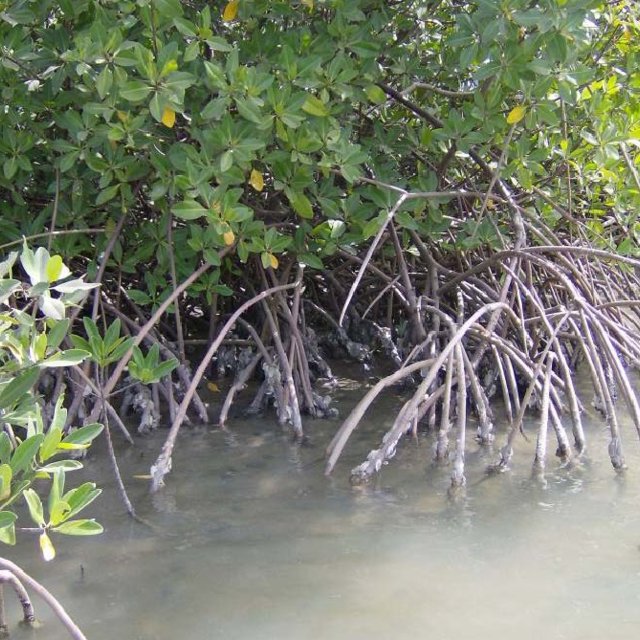Invisible fisheries such as oysters, though minimal and less harvested in comparison to fish, are of nutritional, medicinal and economic value. Oysters are a source of nutrients in the form of protein to many people in West Africa including Ghana. The West African Mangrove Oyster (WAMO) is a source of protein and contains low amounts of cholesterol as compared to other animal protein. It’s a source of amino acids and fatty acids vital for human well-being.
The shells provide calcium and are used in the preparation of poultry and livestock feed. In addition, the shells serve as an ingredient in paint preparations, a rough base for footpaths, cement for building, and raw a material for pharmaceutical industries.
Ecologically, sessile organisms like oysters are important in the aquatic food chain. Oysters are filter-feeders, and while they feed on plankton they help improve water quality. The settling behaviour of oyster spats with time forms reefs which provide structured habitats in estuaries and lagoons for many fish species and crabs.
In Ghana, the WAMO is widely occurring in mangroves, sediments and compact substrates of coastal water-bodies. In the country, oyster populations in estuaries and lagoons are declining. As at 1996, about nine out of the 41 wetland ecosystems had lost their oyster populations according to research.
The statistics are likely to increase as the study dates back to two decades ago – with this likely to be exacerbated by the recent rate of increase in pollution of Ghana’s water resources. Meanwhile, there is a huge potential for most of these wetlands to be used for culturing oysters on commercial basis for economic gain to the country – as practiced in some countries like the Gambia, Egypt and Australia (Obodai, 1999).
Furthermore, according to research 48 percent of the estuaries and lagoons in Ghana were found to be suitable for commercial cultivation of oysters; suggesting a high potential for their use in aquaculture to augment catches from the wild – for which the Densu estuary is no exception. The Densu estuary in Ghana is a habitat for Crassostrea tulipa, also known as West African Mangrove Oyster. The population is currently harvested for commercial use and supports the livelihood of riparian coastal communities. There exists several studies on oyster fisheries in Ghana and elsewhere.
Most of these studies were centred on oyster socio-economics, biology and culture-potential of oysters. Meanwhile, there is no information on the interactions between size and abundance of wild mangrove oysters with the environment for use as an indicator of natural aquatic variability in the Densu estuary. Water quality factors, invertebrates, algae, foraminefera, birds, macrophytes and fish have been the conventional indicators used in Ghana for assessing environmental health and managing aquatic systems.
The high mobility of birds, fin-fish, short life-span of algae, frequent changes in water quality requiring a longer period of monitoring, present a challenge to their sustainable usage. However, oysters are sedentary organisms that are cosmopolitan in nature, have the ability to filter pollutants and store biogeochemical data – thereby reflecting the health of estuarine environments better than other known aquatic bio indicators. In many regions of the world, extensive studies have been carried out on oysters and mussels as ecological indicators of environmental variability.
However, in Ghana scant scientific studies have been done on the use of oysters. Also, it has been documented that as filter-feeders, oysters filter a lot of pollutants and are considered as good indicators of environmental changes in water.
Conversely, due to the possibly different environmental conditions of the Densu estuary and the rising need for identification of indicators in the current environmental uncertainty, there is a need to undertake this current research to guide stakeholders in making informed decisions on the possible adoption or otherwise of West African Mangrove Oysters as an early warning signal of changes in estuarine environments for the development, management and sustainable exploitation of oyster fisheries in Ghana.
Challenges
Out of 10 estuaries investigated on the coast of Ghana for their suitability for culturing oysters, two – namely the Densu and Lower Volta – are located in the Greater Accra Region. The Densu estuary is the most important in terms of Oyster fishery in the region.
It currently supports a thriving commercial oyster fishery under the Development Action Association (DAA) project funded by USAID, and remains an important coastal water-body in Greater Accra. Information on aspects of the ecology of C. tulipa bordering on food habits of the West African Mangrove Oyster and its interaction with the natural environment in the Densu estuary is lacking.
Also, despite scientific proof on the detrimental impacts of estuarine acidification on oysters, there is a dearth of information on the influences of acidification factors on the Densu oyster population in Ghana.
There are indications that many coastal wetlands along the Gulf of Guinea Large Marine Ecosystem (GLME) of Ghana – of which the Densu estuary is no exception, is under increasing threat of contamination from incessant human activities such as oil-drilling, farming activities and improper disposal of waste from household and industrial sources. Several works have reiterated the deteriorating state of Densu estuary and its tributary – with impacts arising from nutrient and trace metal loads.
Feedback from oyster collectors in Densu indicates oyster size and harvest have currently reduced. Presently, most of the brackish systems in Ghana which had thriving oyster populations are recording decreases. The declining state of oyster stocks in the country and concurrent contamination of the delta give justification for detailed studies to heighten the need for conservation and urgent management attention.
No known study on the Densu estuary or any other coastal wetland in Ghana has attempted to investigate the interactions between C. tulipa and the aquatic environment for use as an indicator of environmental changes.
Meanwhile, in this period of climate change and variability, estuaries are classified as highly vulnerable due to their close ties to the sea, according to World Bank report. The likely impacts will stem from a rise in the sea level, changing temperature and estuarine acidification. These impacts are likely to have profound effects on shell-bearing organisms like the West African oyster.
According to reports of the regional climate vulnerability studies by the World Bank in 2017, Ghana will be significantly impacted by variability in climate. The impacts will arise due to high annual temperatures from heat stress and precipitation with warming, which will impact greatly on fisheries resources in sub-Saharan Africa.
Despite these envisaged challenges, the uniqueness of this sub-artisanal fishery lies in the fact that – although fishing is generally recognised as a male-dominated field in Ghana, the harvesting, processing and marketing of oysters is dominated by women. These roles of women in the oyster industry have contributed significantly to the reduction of poverty and enhanced food security within deprived communities. Sustainable management of the fishery would ensure a continuous, nutritional and economic support to this vulnerable group and society as a whole.
Therefore, for viable management and development of the oyster industry as well as its culture, there is a need to acquire scientific knowledge on the environment and aspects of the species’ biology. This work will not only be useful for managing the fishery, but also inform frontiers of knowledge on growth and use of the oyster as an early warning signal of environmental perturbations.
The findings of this research will be useful in policy formulation by being leveraged into the Ghana national fisheries policy in its bid to enhance and deepen marine stock recovery, as planned in the 2020 Ghana budget and economic policy. It is said that uncontrolled, unsustainable mangrove-cutting without replacement depletes the habitats of oysters – and thus limits their ability to absorb about 5 – 8 times atmospheric carbon while contributing to global warming.
Moreover, the discharge of sewage into estuaries and unsustainable farming activities introduce high levels of pollutants and harmful chemicals like heavy metals which kill organisms, harms humans and degrades the quality of water. Furthermore, he presence of pollutants reduces oyster production, interrupts with the filtering of pollutants from upland run-off, destabilises bottom sediments where oysters thrive, increases shoreline erosion and reduces the protective capacity of the estuary from shoreline erosion. It has also been discovered that heavily silted water is vulnerable to flood occurrences during heavy rains, and may destroy property and lives.
According to Senior Lecturer at the Department of Aquaculture, Dr. Sandra Atindana, the main aim of this study is to assess possible use of the West African Mangrove Oyster as a bio-indicator of aquatic environmental variability to enhance sustainable management of the fishery, from the perspective of global environmental change in Ghana.
For sustainable oyster fisheries, government, the metropolitan assembly and all relevant stakeholders should: institute policies on treatment of sewage before discharge into water; sensitise populace on sustainable ways of cutting mangroves; and create a buffer zone along the wetlands.
We as researchers at the Department of Fisheries and Aquatic resources management at the University for Development Studies (UDS) have been undertaking research activities, and also train most of our students to undertake research that will yield good results. We are appealing to government and corporate organisations for collaboration to undertake research activities which will help identify/utilise the sector’s economic viability.
>>>the writer can be reached on [email protected] 0205163280










